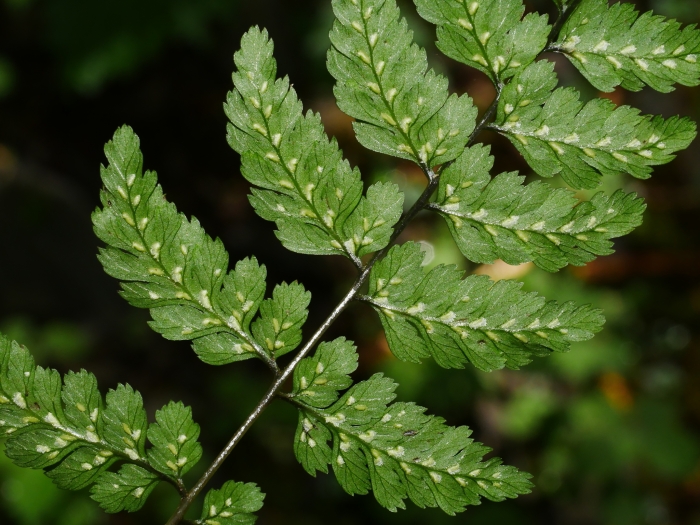Black-Stemmed Lady Fern
(Athyrium nigripes)
Black-Stemmed Lady Fern (Athyrium nigripes)
/
/

Jacy Chen
CC BY 4.0
Image By:
Jacy Chen
Recorded By:
Copyright:
CC BY 4.0
Copyright Notice:
Photo by: Jacy Chen | License Type: CC BY 4.0 | License URL: http://creativecommons.org/licenses/by/4.0/ | Rights Holder: Jacy Chen | Publisher: iNaturalist | Date Created: 2022-07-16T13:43:54-07:00 |












Estimated Native Range
Summary
Athyrium nigripes, commonly known as Black-Stemmed Lady Fern or Japanese Lady Fern, is a deciduous fern native to the understory of temperate forests in East Asia, including Japan, Korea, Taiwan, and parts of China. It thrives in moist, shaded environments such as forest floors and ravines, often on slopes where the soil is rich in organic matter and well-drained. This fern typically grows at a moderate rate to a height of 1.5-3 feet (0.46-0.9 meters) and a width of 1.5-2.5 feet (0.5-0.8 meters). Its appearance is characterized by its striking dark purple or black stems, which contrast with the delicate, bright green, bipinnate fronds. The fronds unfurl in a vase-like form, creating an elegant texture in the garden. Flowering is not applicable to ferns as they reproduce via spores.
Black-Stemmed Lady Fern is valued for its ornamental foliage and its ability to thrive in shady garden spots where other plants may struggle. It is an excellent choice for woodland gardens, shade gardens, and naturalized areas. It can also be used as a border plant or ground cover. This fern requires consistently moist soil, but it is important to avoid waterlogged conditions. It prefers part shade to full shade and grows best in medium or fast-draining loam or sandy soils. While generally low-maintenance, it can be susceptible to pests such as aphids and diseases like rust, especially when grown in suboptimal conditions.CC BY-SA 4.0
Black-Stemmed Lady Fern is valued for its ornamental foliage and its ability to thrive in shady garden spots where other plants may struggle. It is an excellent choice for woodland gardens, shade gardens, and naturalized areas. It can also be used as a border plant or ground cover. This fern requires consistently moist soil, but it is important to avoid waterlogged conditions. It prefers part shade to full shade and grows best in medium or fast-draining loam or sandy soils. While generally low-maintenance, it can be susceptible to pests such as aphids and diseases like rust, especially when grown in suboptimal conditions.CC BY-SA 4.0
Plant Description
- Plant Type: Fern
- Height: 1.5-3 feet
- Width: 1.5-2.5 feet
- Growth Rate: Moderate
- Flower Color: N/A
- Flowering Season: Non-Flowering
- Leaf Retention: Deciduous
Growth Requirements
- Sun: Part Shade, Full Shade
- Water: Medium
- Drainage: Medium, Fast
Common Uses
Border Plant, Low Maintenance, Potted Plant
Natural Habitat
native to the understory of temperate forests in East Asia, including Japan, Korea, Taiwan, and parts of China
Other Names
Common Names: Japanese Lady Fern
Scientific Names: , Athyrium nigripes, Allantodia paludosa, Aspidium costale, Aspidium nigripes, Asplenium denticulatum, Asplenium incisum, Asplenium nigripes, Asplenium paludosum, Asplenium tozanense
GBIF Accepted Name: